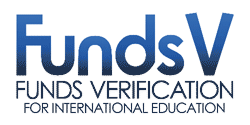International Educators
- About USjournal.com, LLC
- Advertising / Promotional Options
- Advertising Rate Card (pdf)
- Academic Program Listing (pdf)

- Current USjournal.com Advertisers
- Current USjournal.com Services
- Follow USjournal on LinkedIn
- FundsV Named Innovation Finalist
- Growth in Online Language Usage
- Multi-lingual Campaign Advantages
- SkyRadio Audio Segment (wma)
- Strategic Partnership with USDOC

- USjournal.communique
- USjournal History
- USjournal Innovation Lab
| usjournal.communiqué — e-Recruitment Trends and Techniques August 2001: The Students' Perspective, and Online Language Usage |
Current research from well-respected sources supports the U.S. Journal of Academics' observations about some interesting online trends from the prospective overseas students' perspective. In a short amount of time - since we launched our site revision on 1 April 2001 - we've noticed a marked increase in the quality of our student inquiries.
Our customized
and copyrighted student selection system, at show.en.html,
has certainly contributed to the advancements. We also theorize that
the students themselves have become more sophisticated, and in essence
"filter themselves."
The fact is, students used to request information from 20 to 30 different U.S. campuses when they visited our site. Now, approximately 30 percent of our visiting students inquire about one single www.usjournal.com sponsor. Slightly less than 75 percent of our students want more information from fewer than five U.S. Journal sponsors.
Like the rest of us, these students go online to solve a problem quickly and efficiently; they don't want to waste time, so they dig a little deeper before divulging their personal contact information. The 'net novelty has worn off, and they recognize the internet as an information tool - as a means to an end, and not an end unto itself.
The bottom
line is that student inquiries via the U.S. Journal of Academics
are extremely valuable, given the fact that we capture more than 20
different info fields about each qualified prospect, and deliver that
information in a dynamic database (please see sponsor.html
for details). Our qualified inquiries definitely warrant prompt attention,
as our goal is a high ratio of inquiries to actual enrollees.
We have also noticed a sizable increase in non-English inquiries to advertisers that have translated portions of their www.usjournal.com campaign. It's a trend that parallels the ever-evolving fluctuations of global online language populations. According to Global Reach Express, the latest worldwide online language statistics show that native English speakers comprise a shrinking portion of the growing total internet pie; the figure now stands at only 45 percent, down from just under 50 percent at the end of last year. Here's a brief comparison of the most popular language figures from December 2000 and July 2001:
| December 2000 | ||
| English | 189.6 million | 49.9 percent |
| Non-English | 190.4 million | 50.1 percent |
| European Languages | 111.8 million | 29.4 percent |
| German | 22.4 million | 5.9 percent |
| Spanish | 19.5 million | 5.0 percent |
| French | 15.2 million | 4.0 percent |
| Italian | 12.3 million | 3.2 percent |
| Asian Languages | 78.6 million | 20.7 percent |
| Japanese | 27.3 million | 7.2 percent |
| Chinese | 28.7 million | 7.6 percent |
| Korean | 15.7 million | 4.1 percent |
| July 2001 | ||
| English | 217.8 million | 45.0 percent |
| Non-English | 266.3 million | 55.0 percent |
| European Languages | 144.4 million | 29.8 percent |
| German | 30.0 million | 6.2 percent |
| Spanish | 20.4 million | 4.5 percent |
| French | 16.6 million | 3.4 percent |
| Italian | 17.5 million | 3.6 percent |
| Portuguese | 12.1 million | 2.5 percent |
| Asian Languages | 121.9 million | 25.2 percent |
| Japanese | 47.3 million | 9.8 percent |
| Chinese | 40.7 million | 8.4 percent |
| Korean | 22.7 million | 4.7 percent |
Clearly, intelligent and targeted internet promotion provides an enormous opportunity for U.S.-based English language programs. As a matter of fact, one U.S. Journal advertiser (Lado International College in Washington, DC) opted to forego any English version of their www.usjournal.com campaign. I admit, I was quite skeptical at first. But six months after we launched their advertisement, Lado is quite pleased with the results of their Spanish advertisement with us.
Here's a very brief overview of online language usage trends, by region:
Latin America: In this region of the world, the big markets are Brazil, Mexico and Argentina. Brazil will reach 42.3 million Internet users by 2006, almost three times the expected number for year-end 2001, according a new Yankee Group Report titled A Second Wave: The Brazilian Internet User Forecast.
"The acceptance and open-mindedness to new technology in Latin America is higher than we find in almost any other part of the world," noted Microsoft CEO Steve Balmer in the latest edition of Latin Trade. (That same issue also noted that Latin America is one of the most rapidly growing areas for executive MBAs.)
It's also interesting to note that a new report from the Pew Internet and American Life Project recently found that half of all Hispanic adults in the U.S. use the internet and email.
Europe: Research shows that European internet users invest significantly less time per month on the web than in the U.S. According to Nielsen Net Ratings, U.K. household users spent only six hours per month (in May 2001), compared to nearly nine hours, 40 minutes in U.S. homes. Interestingly enough, Europeans view more sites than North Americans, but spend less time on each page.
iTV and mobile telephony are better developed in Europe than in the U.S. Couple this with a lower penetration of computers at home, and it's clear that a multi-channel strategy can be more necessary in Europe. For example, in Italy computer penetration is at 29 percent, compared to mobile telephony, which is now around 70 percent.
Other professional observations: Nordic countries have the highest internet penetration but the lowest e-commerce development. E-banking is highly developed in Germany, but not in the U.K. Some similarities exist: Most Europeans tend to spend about 30 minutes on each on-line session, and majority prefer top generic portals and ISPs.
The internet is not yet a broad mass communication channel in Europe; however, for its own technological nature, the internet is the perfect channel to target the young and the affluent.
Asia: The number of women using the Internet in the Asia-Pacific region has increased by an average of 36 percent since January 2001. The latest report from Nielsen NetRatings says that women now comprise 48 percent of the Australian Net audience, and 46 percent of New Zealand internet users. Use of the internet by women in South Korea is also increasing; they now make up 45 percent of the online population there. Hong Kong follows at 44 percent, while Singapore and Taiwan are next with 42 percent and 41 percent, respectively. Asian men still spend longer online than women in the region do: 14.5 hours per user per month on average, in comparison with 12 hours for women. Nielsen NetRatings' analysts say this is partly because women tend to find what they are looking for online, and they log off rather than continuing to browse.
Middle East: The Washington Post reports that in Tehran, Iran, internet cafés open at a rate of one per day. Though the internet became available only 18 months ago in Iran, there are currently 450 internet cafés in Tehran.
This communique obviously only scratches the surface; we would be delighted to assist you in enhancing your online international student recruitment efforts. Call us at 570-339-4731, or contact us for details. Thanks!
You are welcome to re-print this usjournal.communiqué in full, under the condition that you include "Reprinted with permission of Cheryl Darrup-Boychuck, U.S. Journal of Academics, cheryl@usjournal.com."
Please let us know if you have other suggestions for topics in usjournal.communiqué. If you would like to subscribe to this brief e-newsletter, please complete the form. Thanks!

